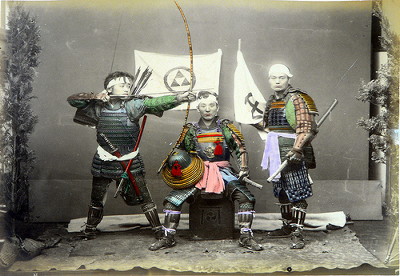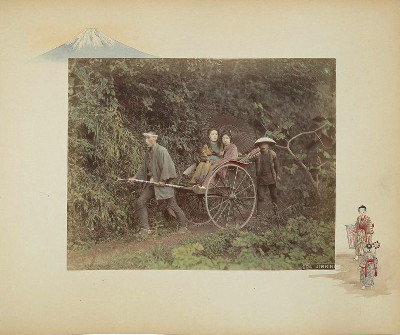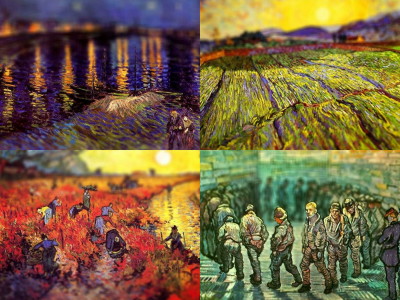Valuable photographs of Japanese landscapes and customs in the 1880s photographed by Italian photographers

Speaking of the 1880s, most Westerners were still unable to enter Japan freely, but the Italians who came to Japan in 1873 in the early Meiji EraAdolfo FalsaariOpened a photo studio in Yokohama and photographed many pictures to sell as a souvenir to foreign residents and foreign travelers.
Photographs manually painted by skilled craftsmen have a fantastic atmosphere, and it is something that the modern Japanese who was not born at that time feels wondrous and nostalgic.
Details are as below.Adolfo Farsari - The Man Who Shot Old Japan | Quazen
The photograph was very expensive for the Japanese at the time, so most of the purchasers are foreigners, and subjects that appeal to tourists are chosen.

Image Credit
Far saarly seems to have captured his own photograph as a business rather than as an art, and I do not know where it was from a natural figure and the direction of people shot, but these pictures are left By doing so, "the image of Japan held by foreigners at the time" and "the image of the Meiji era held by contemporary Japanese people" may be rather close.

Image Credit
A picture of sumo wrestling titled "Wrestlers" (1886).

Farcari is 1841Vicenzabirth. In 1859Secondary Italian Revolutionary WarIn 1963 he moved to the United States and became an enthusiastic slavery abolitionist, until the end of the Civil WarUnion ArmyAs a member of the army, married to an American marriage and two children also sent a wild life to get divorced in 1873 and come to Japan alone. After I came to Japan, I established a business association dealing in sundries and books, sightseeing maps and sightseeing photos in Yokohama, and I also write and publish Japanese travel guidebooks myself. From 1883 he studied photography by himself, and in 1885 he signed a partnership with Japanese photographer Kozaburo Tamamura and was already operating in YokohamaStillfried & amp; Andersen StudioI started a career as a commercial photographer in earnest by acquiring.
A photograph of a rickshaw ride carrying two women entitled "Jinriki" (1886). It seems that the photo was put on the mount of such a picture and sold as an album.

Photograph entitled "Rooms" (1886). I can imagine that a foreign tourist at that time brought it back to his country and talked about souvenirs such as "I take my shoes off in these Tatami rooms in Japan."

The photograph was a monochrome egg paper photo, and Japanese coloring craftsmen had painted by hand using the best quality material of those days. Skilled artisans are able to finish 2 to 3 color photographs per day with high quality, it seems that they were extremely expensive.

Image Credit
Is it a festival line? It is a scene that can be snapped instantly with the current camera, but at that time the camera had to be kept stationary for about 5 seconds while exposing. Looking closely it is because the model has moved rather than a photographer who has a blur.

Image Credit
This cooking scenery is also directed by a photographer and thought to have been positively taken with a pose, but it seems that it is quite naturally finished, such as the hand with knives and the gaze of a woman.

Image Credit
A craftsman laying an umbrella. This should also be taken stationary, but it looks like a historical play of a steel picture.

Image Credit
In most foreign languages bonsai is "BonsaiThere are many enthusiasts abroad, but this may be the first one that told the foreigners of bonsai in the photograph.

Image Credit
Yakata boat.

Image Credit
The reason why the photograph of Farcari was popular was not only that it was a few foreign photographers who were active in Japan in the latter half of the 1880s (the only one since 1887), as well as high photography, development, Although it is cited that we used materials of the highest quality with coloring technology and offered products of high quality sticking to the album's binding etc, but we also looked at the sense of how to choose subjects · composition · framing etc You can take it.

Image Credit
Mt. Fuji backed by "Tagonowrabashi"TajiriuraPicture with a bridge

Image Credit
Scenery of port town. Japanese-style buildings and brick buildings and Japanese-style buildings are mixed, is it Yokohama?

Image Credit
Street lamps etc. are in place properly.

Image Credit
Photographed from 1885 to 1890 entitled "Tennonji, Osaka"ShitennojiPhoto of. Many of Falsari's people and customs photographs based in Yokohama were photographed in Kanto such as Tokyo, Yokohama, Kamakura, Hakone, but the landscape and sightseeing of various places taken by traveling throughout Japan over several months Many pictures are left.

Kinkaku reflected in Kagami Pond. Even coloring is natural, even if it is said that a color photograph taken several decades ago is faded, it seems to believe.

Image Credit
The photograph of Farcari was also the source of the painter 's inspiration. As it is the era when photolithography technology has not yet developed, there are many paintings and illustrations drawn on the basis of photographs in the sense of "reproduction" as a matter of course, but photographs of Farcari are also included in the motif of art works It is being done. ContemporaryJaponismeAs a painterBased on Ukiyo-eI drew a pictureVan GoghIt is famous for such as French painterLouis-Jules DumoulinThe work "Boys' Festival from the Bluff, Yokohama (Yokohama · Tannen no Sekko)" is like a superimposition of carp streamers based on photographs of Kyoto taken by Far Sari.
Kyoto entitled "Gionmachi, Kioto"Shijō-tōPicture of the year (1886).

"Boys' Festival from the Bluff, Yokohama" (1887) by Louis-Jules Dumoulin.

This picture, which is called "Officer's Daughter" (daughter of the officer) is probably one of the most famous ones in the photograph of Far saarly, but actually there is a possibility that Farzarisi remained in the studio acquired at the start of business, and others There are also possibilities that you got in stock or negative exchanges with commercial photographers, and it seems that the photographer is not clear.

However, the same woman as the above picture seems to be a model This photograph is also regarded as Falsaari's work, so it seems that the "daughter of the officer" is also the highest likelihood of being Falsaari work.

Image Credit
It is Far saly who got a daughter named "Kiku" with a Japanese woman in 1885, but I do not know whether I got married officially with this woman. It is said that a sense of nostalgia for Italy, which had been more than a quarter of a century since 1863, followed, returning home with his daughter in 1890. After that, Farserari died on 6 February 1898, 4 days before his 57th birthday in his home Vicenza.
In addition to this, you can see various colorful photographs of Japan in the 1880s by Adolfo Farcari from the following site.
Japon 1886 - Adolfo Farsari - a set on Flickr
Related Posts:
in Creation, Posted by darkhorse_log







